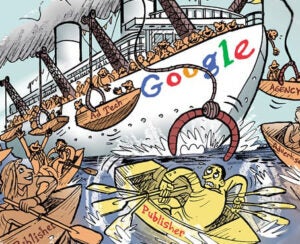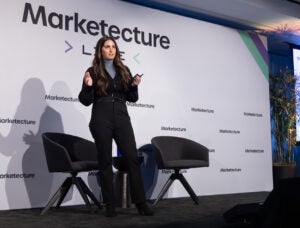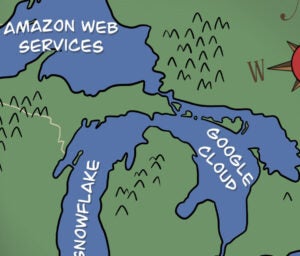 “Data-Driven Thinking” is written by members of the media community and contains fresh ideas on the digital revolution in media.
“Data-Driven Thinking” is written by members of the media community and contains fresh ideas on the digital revolution in media.
Today’s column is written by Jeremy Hines, a principal at Infinitive.
In politics, there is a long-running and often passionate debate about the right level of taxation. One side says lower tax rates lead to higher revenues, thanks to a growing economy, while the other side says raising taxes is the only way to increase revenue.
In digital advertising, there seems to be little debate about the so-called technology tax. Agencies, publishers and other stakeholders agree the tech tax is too high and often unnecessary. A Gartner analyst has even likened it to the shady practice of high-frequency trading on Wall Street.
The tech tax refers to the small cut of every digital advertising transaction taken by middlemen, including ad networks, demand-side and supply-side platforms, data aggregators and suppliers, and vendors of solutions for tag management, yield management, optimization, verification and tracking. Each provides distinct services for a seemingly small fee. But 6 cents here, 3 cents there and so on can add up to a significant chunk of every dollar. Industry observers estimate that the tech tax consumes 40% to 60% of ad sales revenue. No wonder publishers are looking for “deductions” to reduce their tech tax rate.
Because the tech tax is a symptom of the excessive complexity in digital advertising, the cure is the simplification, standardization and rationalization of the tech stack. Resisting “shiny new object” syndrome, or the temptation to adopt every hot new tool that generates buzz, is also key.
Align The Stack
The process starts with some strategic soul searching. Publishers, especially, must be brutally honest about their technology needs. There may be a technology solution to every problem, but not everyone has the same problems and the solutions may not be worth the cost.
Figuring out which technologies are essential starts with understanding one’s unique differentiator. Do marketers come to you because you offer access to senior business executives or because you offer great scale across a range of demographics? Are you known for having a flexible product portfolio or terrific client service?
The answers can help filter and align a tech stack so those differentiators can be monetized and unique offerings clearly defined to the market. For instance, publishers serving premium brands may de-emphasize self-service buying tools to focus on developing skilled sales teams and custom campaign packages.
If the focus is the ability to reach brand advocates, different yield-management features are needed to deliver returns on campaigns targeted at small numbers of consumers, compared to a property with a more generalized audience. Similarly, investing in a data-management platform will be critical for media properties seeking to extend their competitive advantage and value proposition by offering more detailed customer insights across channels to advertisers.
Then there is the matter of duplicative tools. Some publishers use two, three or even four ad servers. The same holds true for content management systems, order management systems, CRM systems and the like. Some publishers even have multiple instances of the same tool. Very rare is the business model that requires such redundancy. Fewer is almost always better, as consolidation can drive volume discounts and lower rates.
AdExchanger Daily
Get our editors’ roundup delivered to your inbox every weekday.
Daily Roundup
Organizational size is a factor, too. If there are five people booking orders, “shoulder-tap” conversations and spreadsheet “solutions” may suffice to manage inventory. Operations with several hundred people involved in booking orders clearly need automated solutions to stay on top of availability in real time.
Healthy Skepticism
A certain skepticism helps reduce tech tax exposure. The default should be to not automatically adopt “shiny new object” technologies that are launched with great fanfare. Instead, publishers and agencies should wait until the market validates the hot tool du jour before adopting it and sacrificing a few more pennies of each dollar sold. Leading edge doesn’t have to be bleeding edge, as those in IT learned long ago.
This skepticism is important because of hidden costs beyond the tech tax. Investing in the latest or most advanced platforms may lead to additional implementation and integration costs or require an expensive team of technologists for ongoing management and maintenance. The ad tech business case must account for these factors.
Lastly, the tech tax is often highest at organizations that believe that systems can solve process problems. Integration and automation of existing processes with current systems may eliminate various workarounds for specific planning, buying, measurement or reporting tasks, which often lead to another tool and small fee. Ad ops teams must assess their current environments for which activities create friction and which systems work well in the big-picture context, such as within an end-to-end order-to-cash process. Then, some process work may reduce the tech tax.
To be clear, powerful technology is critical to success in digital advertising. But using technology to gain a business advantage is a double-edged sword. The right technologies can drive efficiencies and provide new revenue streams, but the wrong mix of tools can strain workflow and end up costing more than the value generated.
Publishers and agencies must continue to invest in the solutions they need, without viewing technology as a panacea. They must also recognize why and how the complexity of the ad tech stack directly correlates with their tech tax rates. Simplification and standardization can save money. It must start with strategic skepticism about the solutions that are essential to the business vs. those that are just shiny and new.
Follow Infinitive (@InfinitiveRocks) and AdExchanger (@adexchanger) on Twitter.












